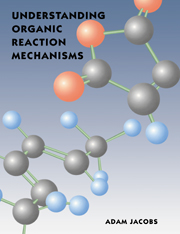Book contents
Summary
Reaction mechanisms are a fundamental part of the study of organic chemistry, and the aim of this book is to help you to understand them. Organic reaction mechanisms are sometimes perceived to be an incoherent and difficult subject, but in fact there are principles underlying them that make them much easier to grasp. Reading this book should give you a mastery of these principles.
Chapter 1 introduces the basics of chemical bonding. This contains a discussion of frontier orbitals (HOMOs and LUMOs), which are an important part of understanding chemical reactivity. Chapters 2 and 3 describe more of the background to understanding reaction mechanisms, namely the nature of ionic species, which are found in the vast majority of reactions, and the driving forces behind reactions. Chapters 4 and 5 look more closely at the molecules that take part in organic reactions, Chapter 4 dealing with species whose reactivity is centred on carbon, and Chapter 5 addressing molecules with other atoms. Chapter 6 describes the reactions themselves. By this stage in the book, most of the principles behind chemical reactivity have already been explained, so the reactions can be seen to be no more than logical consequences of these. Chapter 7 is something of an aside, and looks at how we know about reaction mechanisms from experimental evidence. Chapter 8 draws on the material presented earlier in the book to help you to suggest mechanisms for unknown reactions, a vital part of any undergraduate chemistry course.
- Type
- Chapter
- Information
- Understanding Organic Reaction Mechanisms , pp. xiii - xivPublisher: Cambridge University PressPrint publication year: 1997



